Russia, the world’s largest country, stretches across Europe and Northern Asia and spans 11 time zones. As such, its natural landscape is vast and filled with a range of environments from deserts to arctic tundras. Russia is also home to many spectacular man-made landmarks such as imposing castles and palaces. Here are 20 landmarks in Russia that should be at the top of your list if you are planning on visiting this incredible country.
Contents
- 30 Landmarks in Russia
- Historic Russian Landmarks
- Natural Landmarks In Russia
- 15- Lake Baikal
- 16- Olkhon Island
- 17- Kungur Ice Cave
- 18- Elton Lake
- 19- Altai Mountains
- 20- The Lena Pillars
- 21- Chegem Waterfalls
- 22- Golubye Ozera
- 23- Sarykum Dune
- 24- Caucasus Towers
- 25- Balagan-Tas Volcano
- 26- Usolsky Salt Deposit
- 27- Burlinskoye Lake
- 28- Kamchatka Peninsula
- 29- Caronian Spit
- 30- The Valley of Geysers
30 Landmarks in Russia
Historic Russian Landmarks
1- Moscow Kremlin
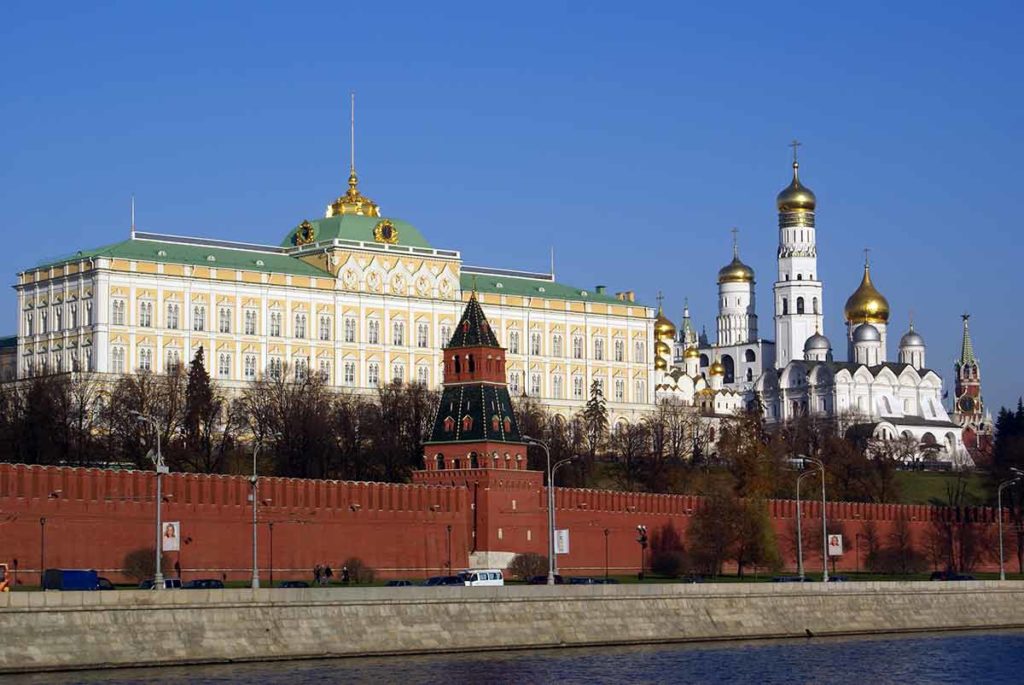
The existing features of the Moscow Kremlin were built between 1485 and 1495 by skilled Italian architects.
Traditionally, the Kremlin was the home of the tsar, until Peter the Great assigned St Petersburg, named after himself, as his seat.
The Kremlin has a turbulent past; in 1917 the Bolshevik Uprising stripped Moscow of its capital status, and during the Soviet period, 28 of the original 54 buildings were destroyed.
Today, the Kremlin opens its doors to the public, with museums housing important objects and artworks opening in 1961.
The Kremlin features many important historical monuments and artefacts, including the Tsar cannon and Tsar bell, both of which are the largest in the world.
The Kremlin is currently the residence of the Russian president.
Read this post about a Russian river cruise.
2- Red Square
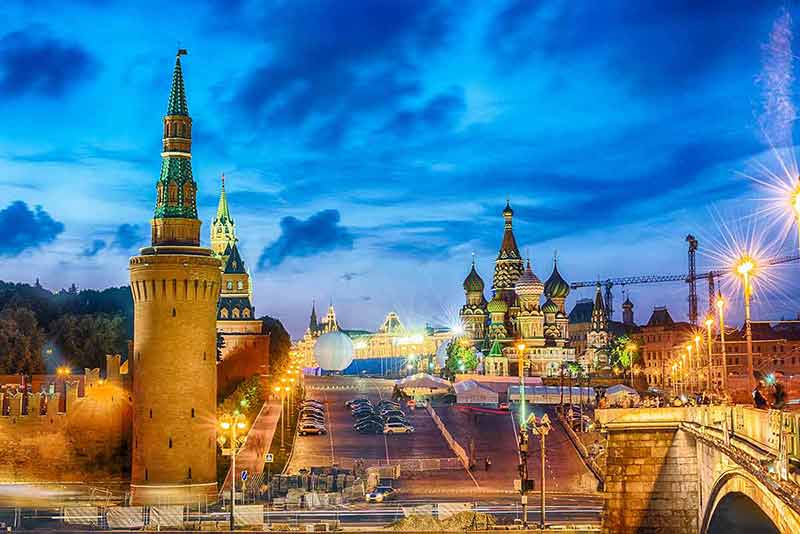
The most famous place in Moscow is Red Square, which forms an important base for Moscow’s history.
Red Square connects St Basils Cathedral and the Kremlin and is named after the brightly coloured bricks that pave the square.
Construction on the square finished in the late 19th century.
The square itself has had many purposes, inclining a marketplace and a Soviet parade ground.
As the square links two of Moscow’s most important landmarks, a stroll through the bustling square to absorb the breathtaking architecture is a must.
3- St Basil’s Cathedral
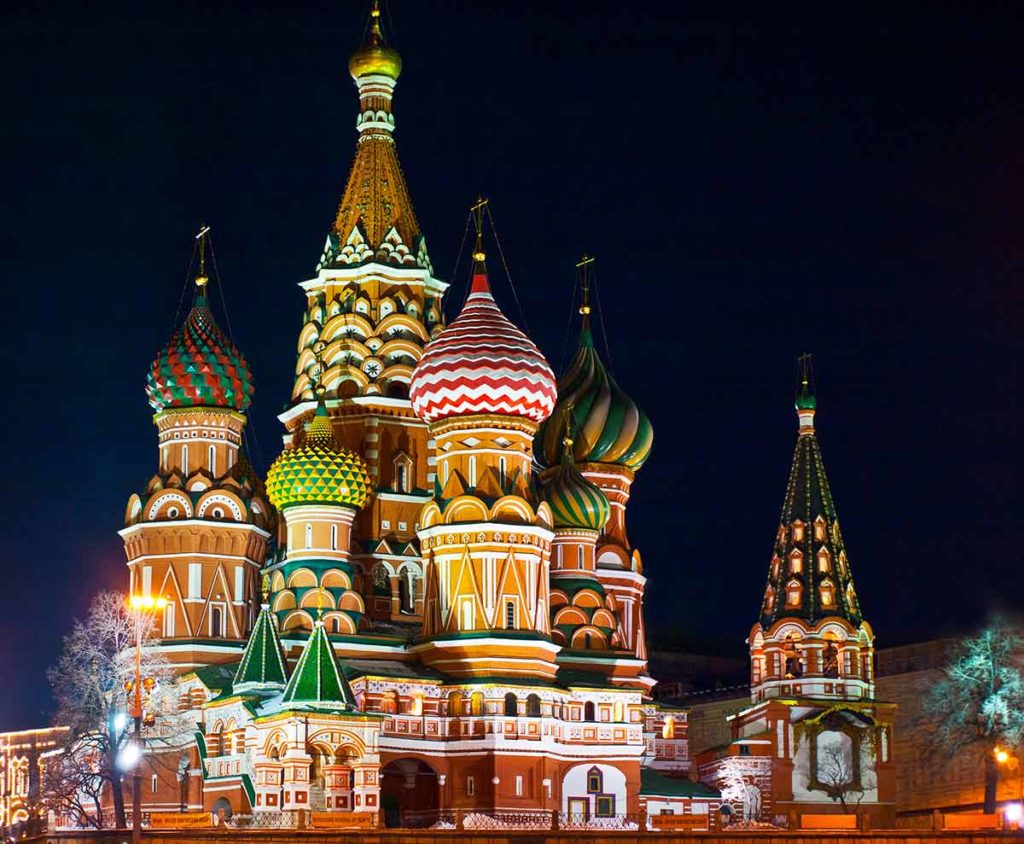
St Basils Cathedral lies to the south of Red Square.
The cathedral, built in 1555 under the orders of Tsar Ivan the Terrible, was designed to symbolise the Heavenly City.
Its walls are bold and colourful and feature many precious stones.
The cathedral is actually nine churches in one, and each section is connected internally by galleries and passages.
The cathedral does come with a grizzly legend.
Ivan the Terrible did not want his cathedral to be replicated anywhere else, and so blinded the architects so they could not recreate this place of worship.
The cathedral has been threatened by many forces.
In 1812 French troops retreating from Moscow had plotted to blow up the cathedral, and in the 1920s the Soviets decided to pull it down.
Luckily the cathedral was saved and is now a world heritage site.
4- St Nilus Stolobensky Monastery
Visiting the monastery of St Nilus Stolobensky on a summers day provides tourists with spectacular views over its cream facade and silver-blue domes.
The monastery is located on a small island in Lake Seliger. Founded by a group of monks between 1591 to 94, the monastery is a collection of many smaller churches and living areas.
Much of the monastery has been rebuilt and restored over the years following damage during the Soviet period.
Visit the Bishop’s Chambers for neoclassical and Gothic Revival architecture.
5- The Winter Palace
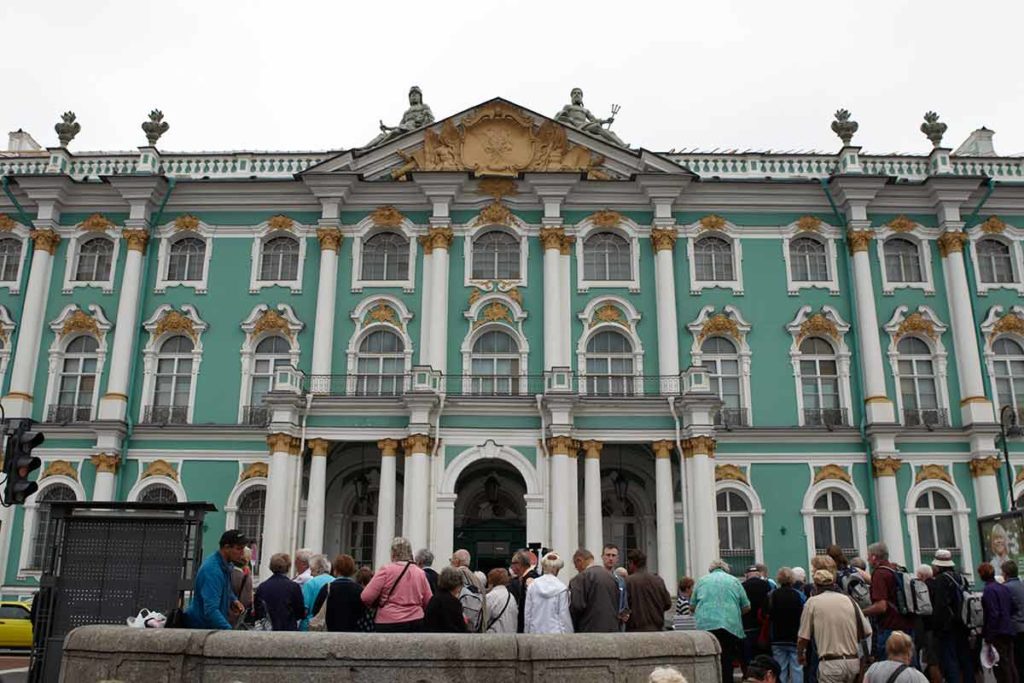
The Winter Palace is St Petersburg’s most famous building and one of the most impressive Russian palaces to visit.
The palace itself is unmissable, with its vivid green colouring adorned with gilded carvings.
The Winter Palace was completed in 1735, but would be expanded in the years that followed before reaching the size it is today.
The palace houses a museum filled with treasures and priceless art collections named the Hermitage Museum.
The Winter Palace has not served as a residency for the Tsars since 1881, however today it is still used as a place to hold official ceremonies.
The building was heavily damaged during the Siege of Leningrad, however, this tragedy did start the process of returning the original splendour of the palace’s many rooms.
The State Rooms, in particular, are now a favourite among visitors.
For more amazing European Landmarks, read:
- 30 Spain Landmarks
- 20 Switzerland Landmarks
- 22 Germany Landmarks
- 35 London Landmarks
- 30 France Landmarks
- 20 Italy Landmarks
- 20 Greece Landmarks
- 20 Russia Landmarks
- 20 Scotland Landmarks
- 20 Ireland Landmarks
- 21 Wales Landmarks
- 20 Turkey Landmarks
- 20 England Landmarks
- 20 Hungary Landmarks
- 21 Romania Landmarks
- 20 Ukraine Landmarks
- 20 Athens Landmarks
- 20 Rome Landmarks
- 20 England Landmarks
- 20 Portugal Landmarks
- 20 Poland Landmarks
- 20 Iceland Landmarks
- 20 Bulgaria Landmarks
- 21 Croatia Landmarks
- 20 Bulgaria Landmarks
- 20 Austria Landmarks
- 21 Finland Landmarks
- 20 Sweden Landmarks
- 20 Denmark Landmarks
- 20 Belgium Landmarks
- 20 Netherlands Landmarks
- 20 Barcelona Landmarks
- 21 Czech Republic Landmarks
- 20 Landmarks in Paris
- 20 Landmarks in Liverpool
- 10 Istanbul Landmarks
6- Kizhi Island
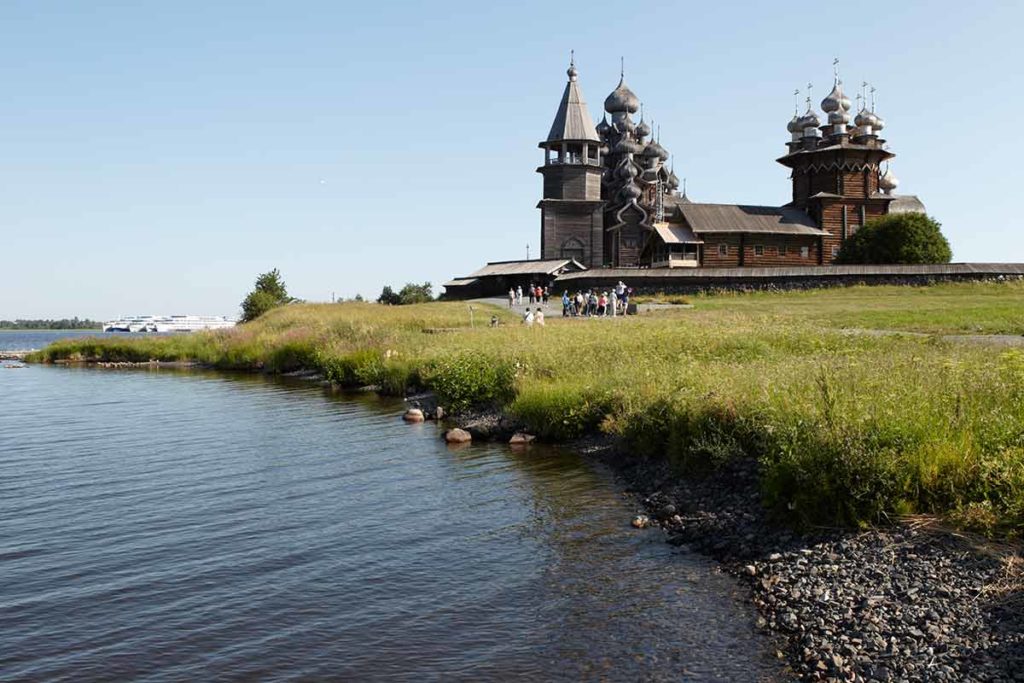
Located in Lake Onega, Kizhi Island is a sight to behold.
On the island are two 18th Century wooden churches and an octagonal clock tower.
The current churches are built on the site of two former 16th Century churches that perished in a fire when lightning struck them.
The churches themselves reflect harmony through the shapes used and showcase complex and artistic Russian carpentry.
7- Catherine Palace
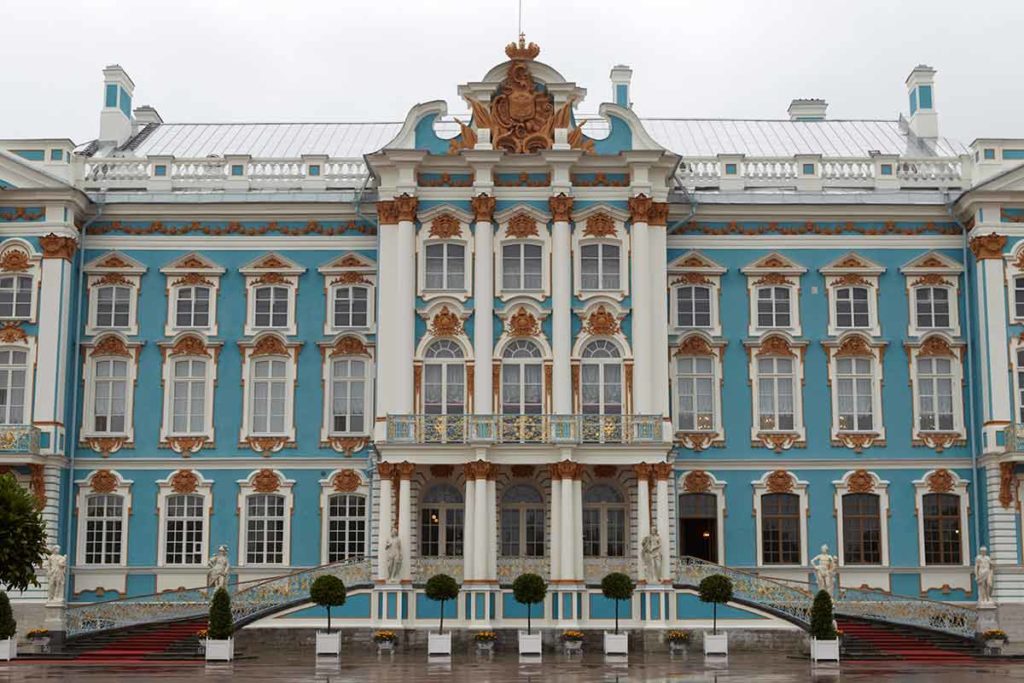
An impressive blue, cream and gold building named after Catherine the First, wife of Peter the Great, Catherine Palace was designed as a rival to the palace of Versailles.
The palace in St Petersburg was completed in 1756 and took over 100kg of cold to decorate the exteriors of the palace, much to Catherine’s dismay.
The palace houses many impressive rooms, including The Great Hall, often referred to as the Hall of Light.
The room occupies the full width of the palace, and large arched windows offer scenic views of either side of the palace, as well as illuminating the treasures within.
The palace is now open to visitors to gaze in awe at the sheer lavishness of the palace. Tours are also available and offer access to the parklands in which the palace sits.
8- Mayakovskaya Metro Station
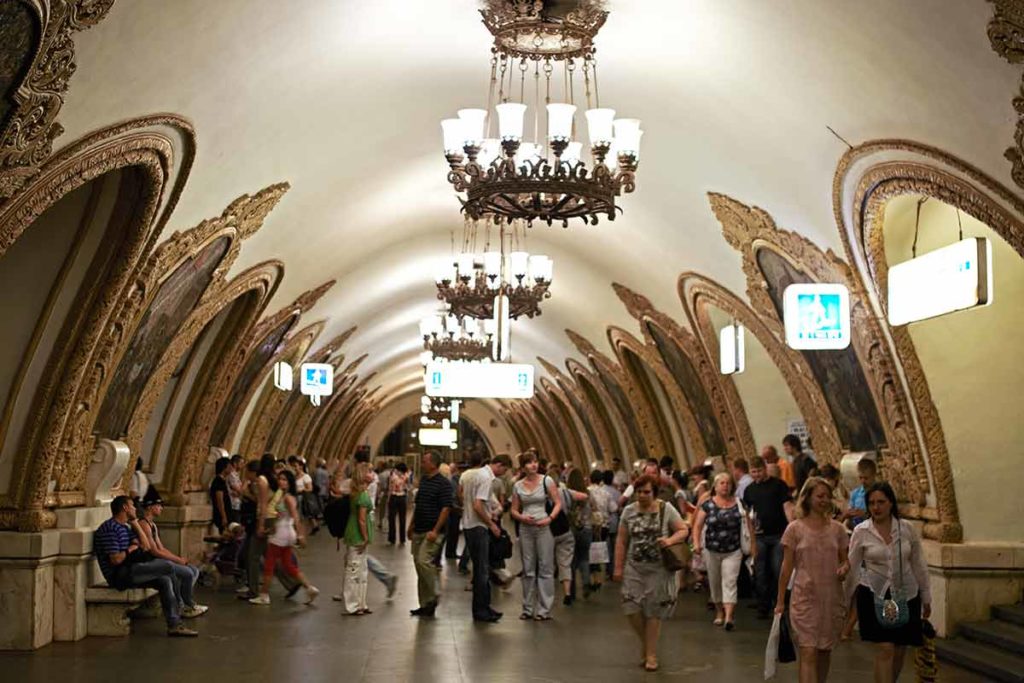
Many see metro stations as merely a stopping point before their train to and from work arrives.
In Moscow however, the Mayakovskaya Metro Station is a thing of beauty.
This station is often regarded as the most beautiful in the world.
An art deco masterpiece, this station was opened in 1938 and was designed by Alexey Dushkin.
Unlike many stations of the time, Dushkin opted to use a lighter metal; favouring aircraft steel over traditional girders, giving the hall a larger more open feel.
Around the metro station, there are many mosaics, adding to the reputation that Moscow’s metro lines have of a museum underground (Dinamo station features Greek friezes and reliefs).
9- Bolshoi Theatre
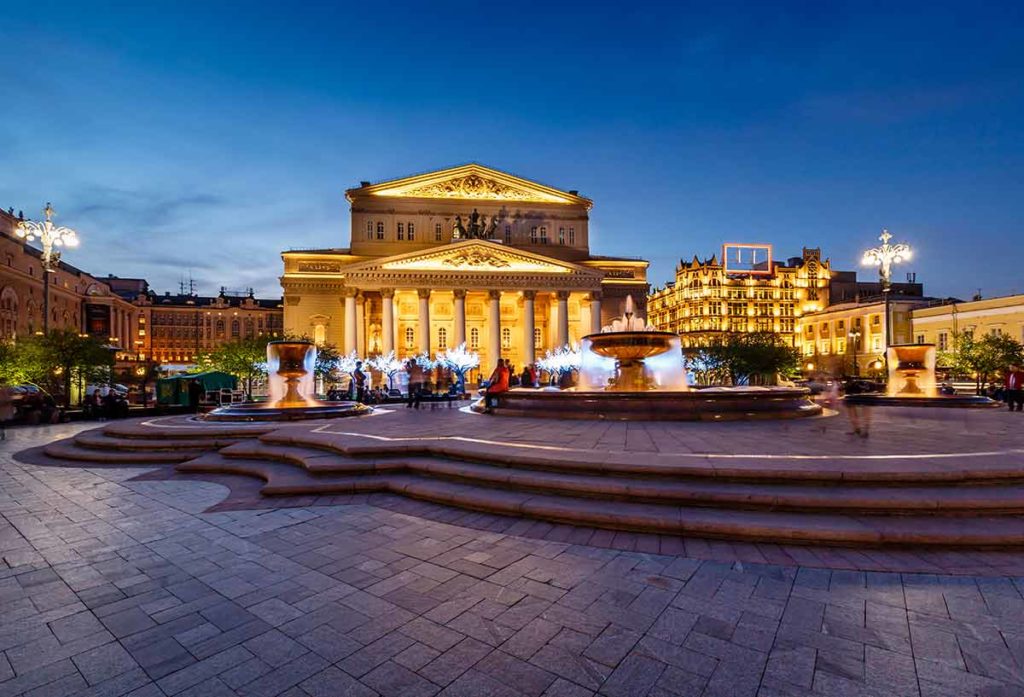
The Bolshoi Theatre is a historic theatre in Moscow, famed for its performances of ballet and operas.
The theatre was initially given permission to be built by Empress Catherine the Second in 1776.
Over time, and after two fires that destroyed much of the original building, the theatre was refurbished and officially opened as the Bolshoi Theatre to coincide with the coronation of Tsar Alexander the Second.
Like many historical buildings in Russia, the theatre was in danger of being demolished.
Today, the theatre has been restored to its former glory after being left in a state of disrepair following bombings during World War Two, and a lack of funding.
Performances at the theatre are world-renowned for their beauty and passion and entice audiences with classical ballet performances and modern adaptations of classical literature.
10- Izmailovo Kremlin
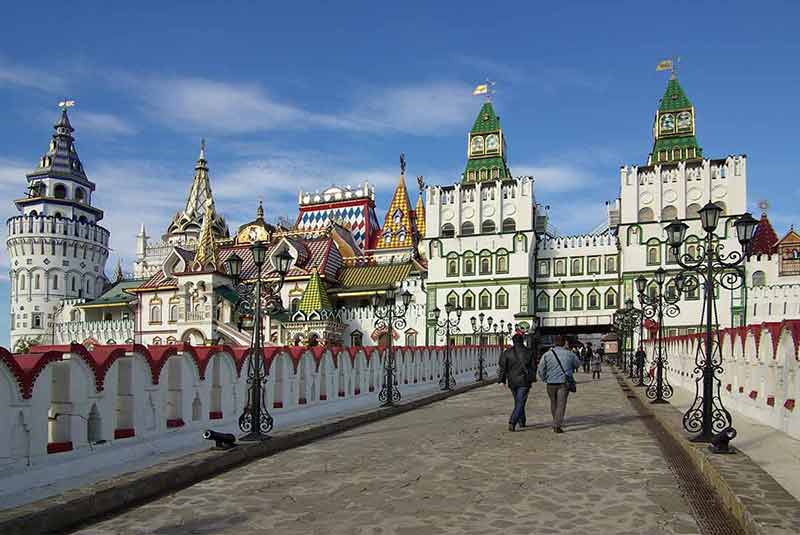
Izmailovo Kremlin might be less well known than the Kremlin in Red Square, however, Moscow’s second Kremlin is just as awe-inspiring.
This fairytale-like structure features whitewashed walls and boldly patterned and decorated rooftops.
Unlike other Kremlins in Russia, built as fortresses, the Izmailovo Kremlin was built as a cultural centre.
Building began in 2007 and the design is loosely modelled after traditional Russian architecture.
You can find hints of this in its bold rooftops, which are similar to those adorning St Basil’s Cathedral.
Within the Kremlin are small museums, each dedicated to a different subject.
Inside, you will find museums for folk art, bread, vodka and several stalls selling traditional Russian crafts.
Izmailovo Kremlin is at 24 3-ya Parkovaya ul. Moscow, 105187.
11- Peterhof Palace
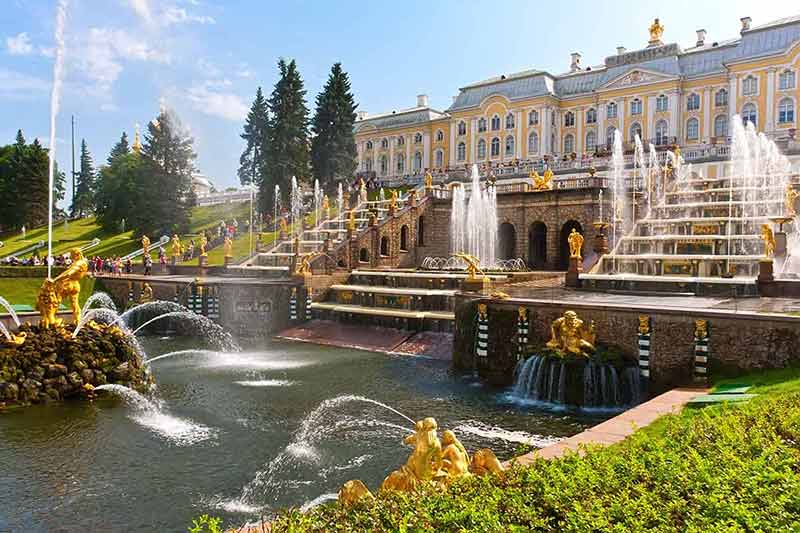
Peterhof is a series of palaces and ornately designed gardens in Saint Petersburg.
Peter the Great commissioned the palace as a rival to the Palace of Versailles.
Domenico Trezzini began work on the palace in 1714, creating much of the Petrine Baroque features still seen today.
Aside from the grand architecture, the biggest lure of Peterhof Palace is its gardens.
The gardens are positioned both inside the palace walls and the surrounding areas.
They were inspired by 17th-century French creations, particularly the pleasure gardens found at Versaille.
Peterhof Palace is at Razvodnaya Ulitsa, 2, St Petersburg.
12- Saviour of the Spilled Blood
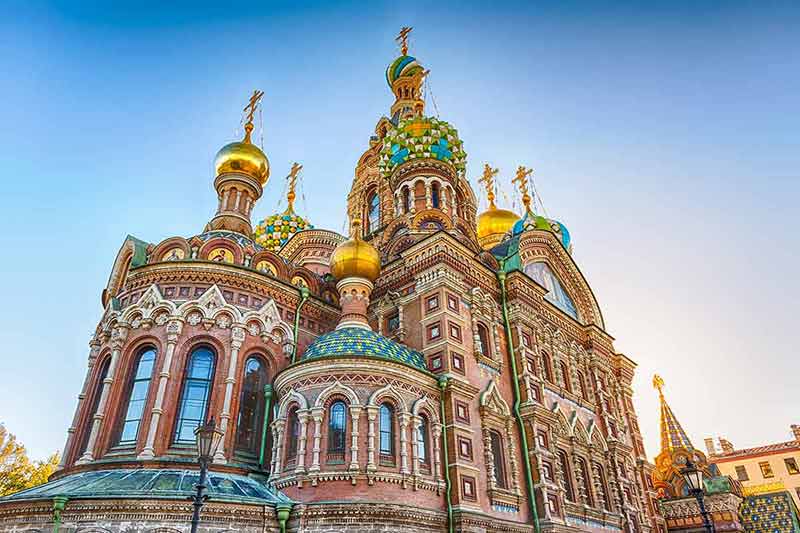
Russia is famed for its stunning churches, and Saviour of the Spilled Blood in St Petersburg is among the most breathtaking.
Alfred Parland designed the church with construction beginning in 1883.
The church was built on the spot where Alexander II was fatally wounded in an assassination attempt in 1881, which gives the church its name.
Parland designed the church in the style of 16th and 17th-century Russian churches, with elaborate decorations, coloured and shaped domes atop the spires and large grand windows.
Saviour of the Spilled Blood is at Griboyedova Kanala Emb., 2B/A, St. Petersburg, 191186.
13- Mariinsky Theatre
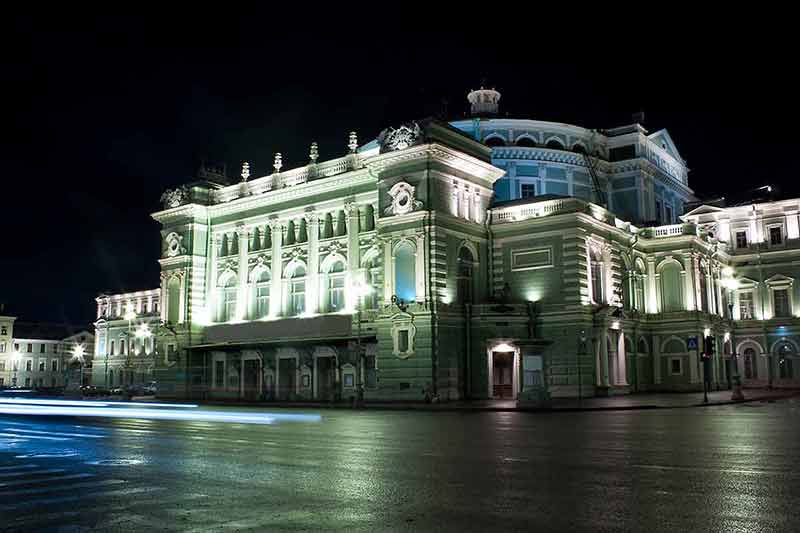
Mariinsky Theatre can trace its roots back to 1783 when a theatre was opened in Theatre Square to show performances and music.
Antonio Rinaldi designed the theatre with further additions from Thomas de Thomas between 1802 and 1803.
The theatre was a marvel of its time with up-to-date technology and machinery, which allowed the performances to be at the forefront of Russian theatre.
The theatre has seen performances from great Russian singers Fydor Chaliapin, Ivan Yershov and Medea, and Ballet dancers Mathilde Kschessinska and Rudolf Nureyev.
Mariinsky Theatre is at 1 Theatre Square.
14- Golden Bridge
Golden Bridge is one of the largest cable-stayed bridges in the world.
The bridge spans 2 kilometres (1.24 miles) and is 30m (98ft) in width.
Authorities discussed plans to build a bridge across the Golden Horn Bay to connect the city to other districts and the highway towards the end of the 19th century.
World Wars I and II and further political disruption prevented the bridge from being built until Vladivostok was chosen as a location for the APEC summit in 2012.
The bridge is accessible by both car and foot, with walking times estimated at 30 minutes from one end to the other.
Golden Bridge is at Golden Horn Bay, Vladivostok.
Natural Landmarks In Russia
15- Lake Baikal
Located in the southeast of Siberia, Lake Baikal is the oldest existing freshwater lake at approximately 20 million-25 million years old.
More than 330 rivers and streams flow into this body of water.
Due to the lake’s location, many hot mineral springs can be found due to breaks in the earth’s crust.
The lake contains many islets and islands including Olkhon and Bolshoy Ushkany.
The lake and islands are home to the Baikal seal, the only freshwater seal in existence.
The pups are born on the icy surface when the lake freezes over between January and May, making this a popular time to travel here for tourists and scientists.
Travel here in summer to view the waters at their deepest blue overlooked by towering mountains.
16- Olkhon Island
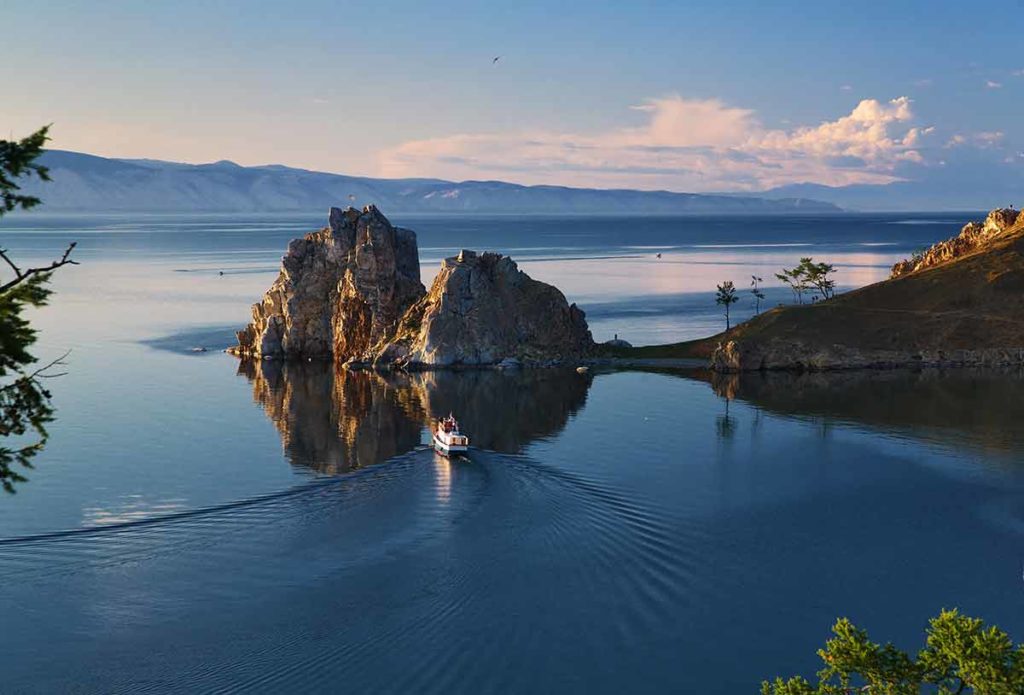
Olkhon Island and Lake Baikal on which it sits, are sacred to the indigenous Buryat people who adorn parts of the island with colourful totems of their Buddhist faith.
Olkhon Island is a rugged landscape of mountains and deep forests and is home to only 1500 people.
The houses here are built in a traditional style, made from wood, and often painted in bright colours.
On the shores of the island, sandy beaches make it easy to forget that you are staring out over a lake and not the sea.
Herds of wild horses roam freely here through the forest.
Olkhon is a world away from the bustle of Russia’s cities and offers travellers a glimpse of pure wilderness, peacefulness and breathtaking views.
17- Kungur Ice Cave
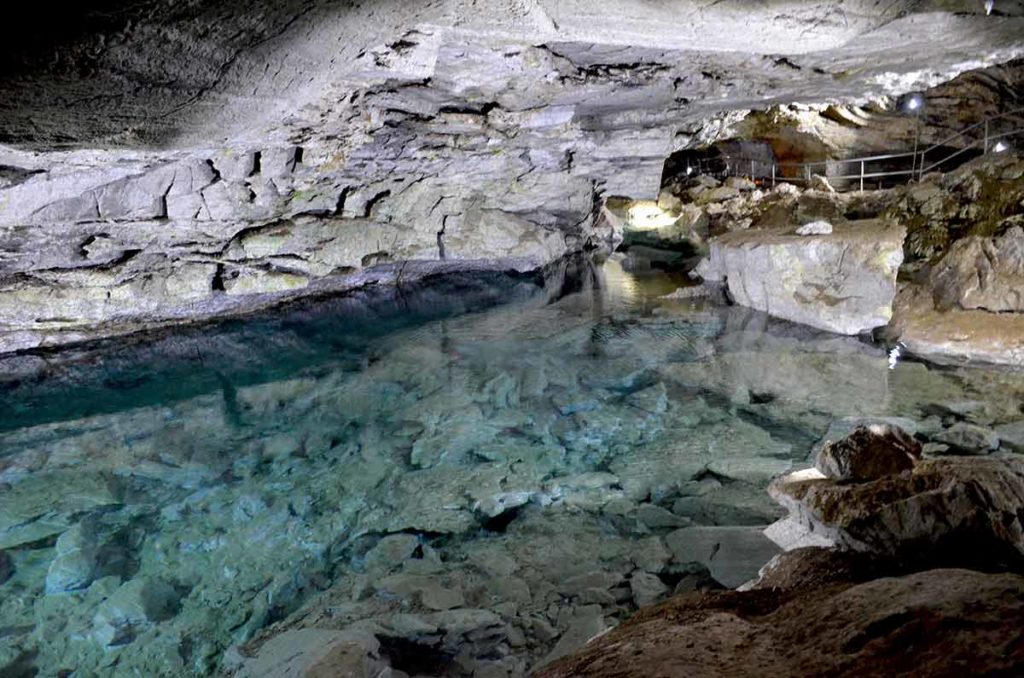
Kungur Ice Cave is another wonder of the natural world nestled inside the vast wilderness of Russia.
The cave is always ice cold, allowing ice crystals to form here.
The cave has dozens of underwater lakes, and as such attracts many visitors.
Over thousands of years, the soft rocks inside the cave were dissolved, giving the cave its peculiarly shaped rock inhabitants.
Icicles reach the floor here, filling the caverns with impressive hourglass shaped columns.
The cave was first visited by people in 1914, and since then has been adapted with specialist lighting rigs to allow visitors to enter and be mesmerised by the magic that awaits them.
Tours run through the cave and offer an insight into the myths and legends that fare here.
18- Elton Lake
Elton Lake is a salt lake near the Russian border with Kazakhstan.
With an area of 59 square miles and a depth of only 1 to 2 feet, this lake is the largest mineral lake in Europe.
The lake is so large and so flat, those beautiful reflections of the sky appear on its surface.
Birds flock here as a stop-off during their migration.
As the salt levels are so high here, when some of the water evaporates, incredible natural salt sculptures are revealed in unique patterns.
19- Altai Mountains
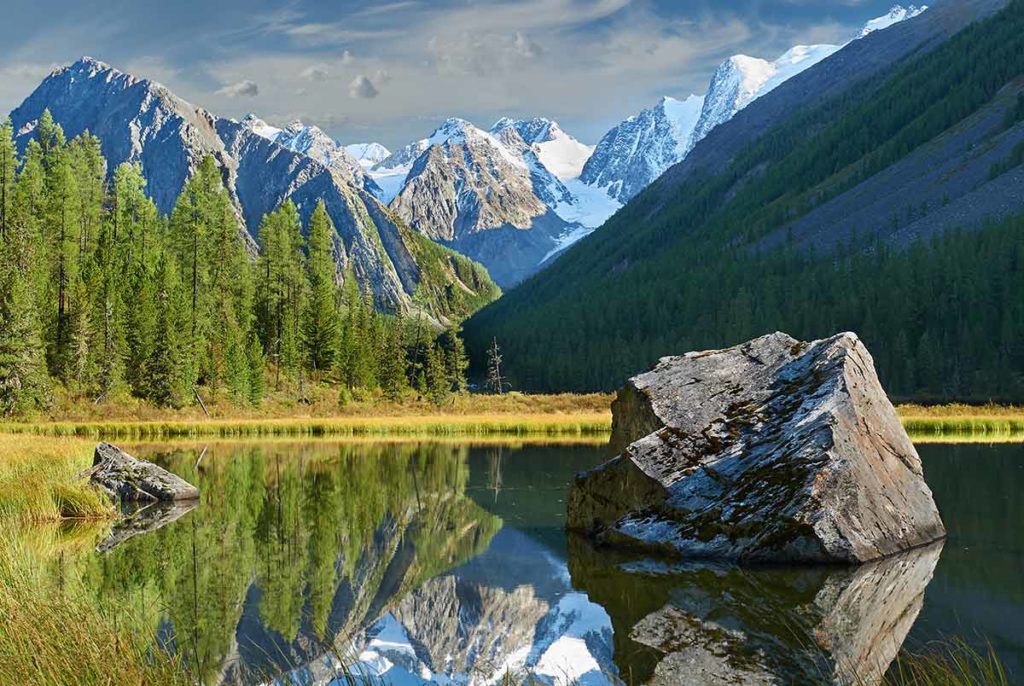
Stretching over Russia, Mongolia, Kazakhstan and China, the Altai Mountains mark the centre of Eurasia.
Mount Belukha is the highest peak in Siberia and is covered with snow and ice all year long. Within the mountain range, there are 1499 glaciers.
As these mountains span such an incredible distance, the landscapes and animals living there vary greatly.
Within the region, the rare snow leopard, ibex and lynx call the mountains their home.
The varying landscape also opens the mountains up to a range of sports, including pass hopping and kayaking down one of the many rivers that flow through the range.
20- The Lena Pillars
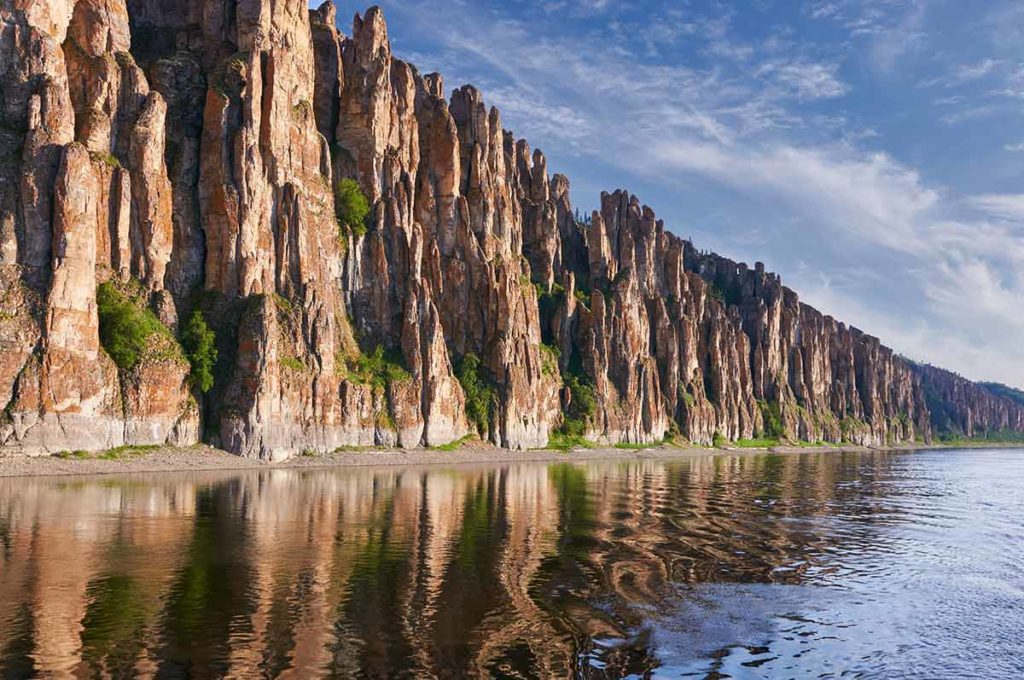
The Lena Pillars are a range of rock pillars stretching as high as 100m that sits along the banks of the Lena River.
The pillars were created by the extreme climate within the region, as temperatures plunge as low as -60°c in winter to over 40°c in summer.
This site is of particular historical interest due to the Cambrian fossils found here, some of which are only found in this region.
The pillars themselves are part of a nature park, making for beautiful walks and incredible picturesque scenery.
The park and the pillars were named as a UNESCO world heritage site in 2012.
21- Chegem Waterfalls
Perhaps one of the most beautiful sights in Russia’s natural landscape is Chegem waterfalls.
The falls vary from small jets of water to wide plumes cascading over the rocks.
Catch the falls at the right time of day, usually between 10 and 11 am, and see the waters turn into the colours of the rainbow as they refract the suns rays.
During winter, the falls freeze over creating pillars of ice and frozen droplets.
The falls are nestled inside the Chegem valley, an ancient settlement within which historical monuments such as the Chegem Burial Houses can be found.
Top Landmarks Around The World:
Discover more Famous World Landmarks:
- 25 Australian Landmarks
- 20 New Zealand Landmarks
- 20 African Landmarks
- 21 Egyptian Landmarks
- 20 Jordan Landmarks
- 10 Tasmanian Landmarks
- 20 Antarctica Landmarks
22- Golubye Ozera
Three lakes form the Golubye Ozera, which means Blue Lakes in Russian.
The name of these lakes comes from the blue hue of the water, which is caused by a blue-coloured mud that sits at the bottom of these lakes.
The lakes are not supplied by any rivers and instead get their water from underground sources.
The lakes are extremely beautiful and are surrounded by idyllic woodlands.
If visiting these magical lakes, you can take part in a number of water-based activities including diving and canoeing over the pristine water.
23- Sarykum Dune
To many, the Russian landscape is harsh and cold, however, the Sarykum Dune would not be out of place in hotter parts of the world.
The Dune, a large sand dune in Dagestan, is part of the Dagestan Nature Reserve.
The Dune itself is extremely old and measures approximately 860 feet high.
The Dune is a unique monument in the region and is recognised by geologists as the second largest sand dune in the world.
Sarykum is seen as a natural phenomenon as most dunes are found either in a desert or beach.
Sarykum is on a large flat area of clay.
24- Caucasus Towers
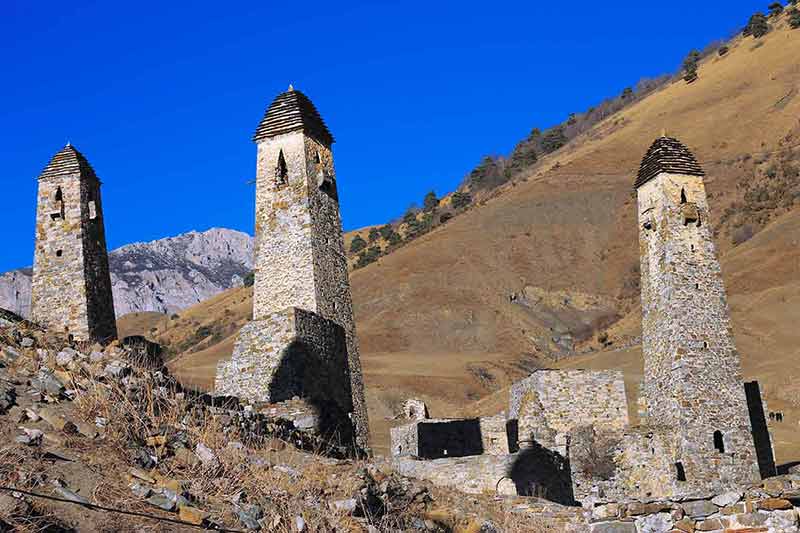
Nestled in the foothills of the North Caucasus region are a collection of hundreds of tall towers.
Built in ancient times by the Ingush and Vainakh people, it is incredible to see these monuments, the majority of which are still intact.
It is believed that the towers were built for defence and for accommodation, and historians believe that each level of the towers had its own purpose.
The ground floor was reserved for stables, the first floor for living accommodation and the top floor for defence.
The balconies around the top floor would have been used to pour boiling liquid from in times of attack.
Ingush towers, which can be seen within this region, were built under strict conditions.
The towers had to be completed within 365 days, and each family of means were required to build one.
To the Ingush people, these towers were of great spiritual importance, as they believed the towers symbolised their spirits.
Each tower is adorned with symbols to reflect the spirituality of the builders and their families.
25- Balagan-Tas Volcano
Balagan-Tas volcano is located in Siberia along the Moma River in the Chersky Range close to the Arctic Circle.
Geologists have been unable to determine the volcano’s age due to its remote location, however, it is believed to be a young volcano at only a few hundred years old.
It has been classified as a dormant volcano due to its date of last eruption in 1775.
Basaltic lava flows spewed out of the cone-shaped cinder volcano and due to this eruption, little remains of the volcano.
It covers 1.8 square kilometres (1.1 miles), and the crater is 200m (660ft) wide.
Balagan-Tas Volcano is at Sakha Republic, Russia, 678863.
More Landmarks in Asia:
26- Usolsky Salt Deposit
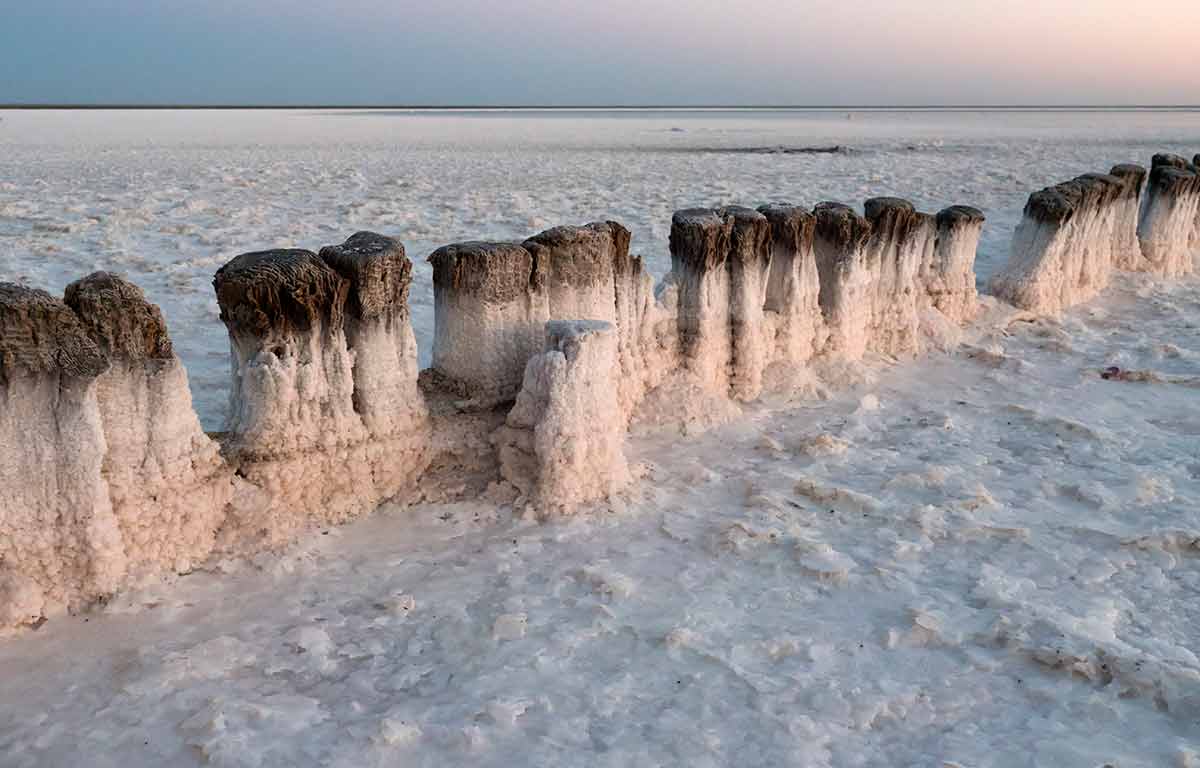
Close to the city of Solikamsk, the Usolsky Salt Deposits is an impressive landscape created by salt mines that date back to the 15th century.
Salt was mined through a series of wooden pipes inserted into the ground.
Only the Lyudmilinskaya borehole, dug in 1906, remains intact and is remarkably well-preserved thanks to the salt.
The first traces of potassium in Russia were found within the salt deposit during the early 20th century.
Usolsky Salt Deposit is at Usoyle-Sibirskoye.
27- Burlinskoye Lake
Another source of salt in Russia comes from Burlinskoye Lake, which was mined for salt until 1984.
Traditionally, the salt from the lake was mined by hand and mechanising the process led to less salt being produced.
The last deposits drawn from the lake were only useful for livestock.
The lake is no deeper than 1m (3.28ft) and is often explored by locals thanks to its shallow depths.
Thanks to the salt and other minerals in the ground, the waters appear pink in colour.
Burlinskoye Lake is at Altai Krai, Russia, 658835.
28- Kamchatka Peninsula
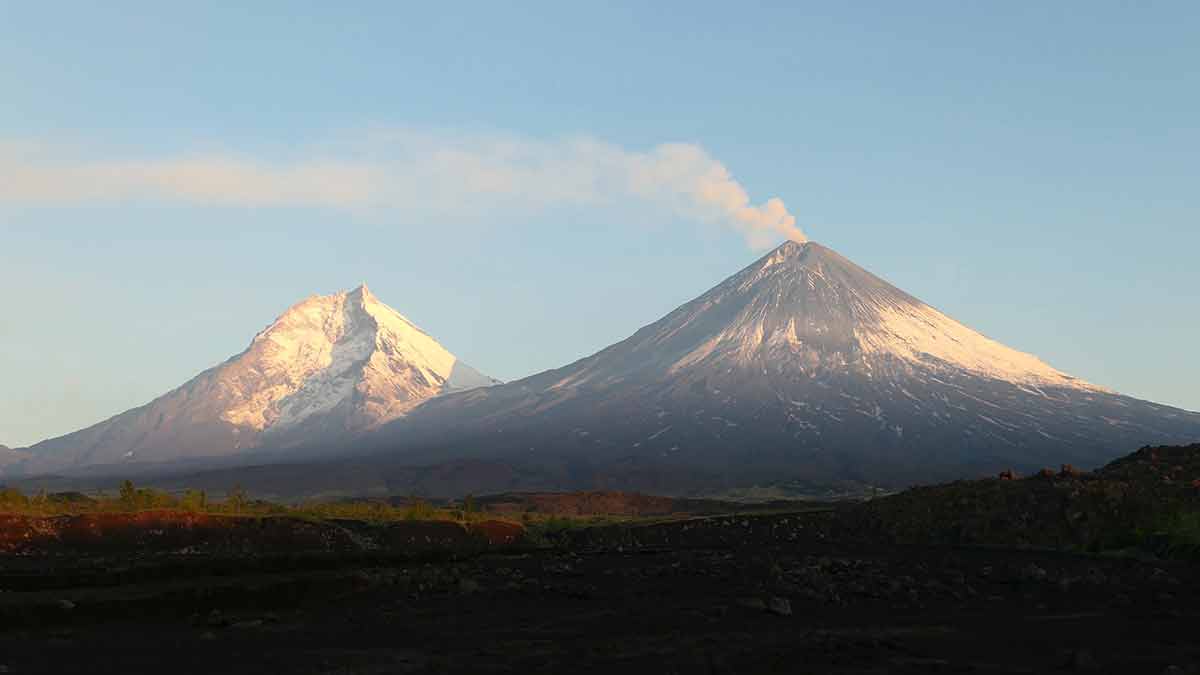
Kamchatka Peninsula is at the most easterly point of Russia.
This vast area is filled with wildlife and a remoteness so great that only adventure travellers brave the journey.
The peninsula contains the most active volcanoes in the world, and as such, has earned the landscape UNESCO World Heritage Site status and protections.
Drawing many visitors to this remote corner of Russia is its wildlife.
Brown bears, sea otters and sea eagles all call the peninsula home.
Many tours run out to the peninsula with the hope of showing these wild animals in their natural habitats to visitors.
Kamchatka Peninsula is at Kamchatka Krai, Russia, 684405.
29- Caronian Spit
Caronian Spit is an unusual 98 km (60.9 miles) sand dune separating the Curonian Lagoon from the Baltic Sea.
The Spit has UNESCO World Heritage Site status, and thanks to its location, this status is shared by both Lithuania in the north and Russia in the south.
The spit was created in the 3rd millennia BC and was formed on a glacier. Wind and sea currents pushed sand onto the glacier, keeping it above sea level.
This unique spot is subject to local Baltic mythology.
According to these myths, a giantess named Nearing played on the seashore, where she piled up and pushed sand into this unique shape.
Caronian Spit is at Kaliningrad Oblast.
30- The Valley of Geysers
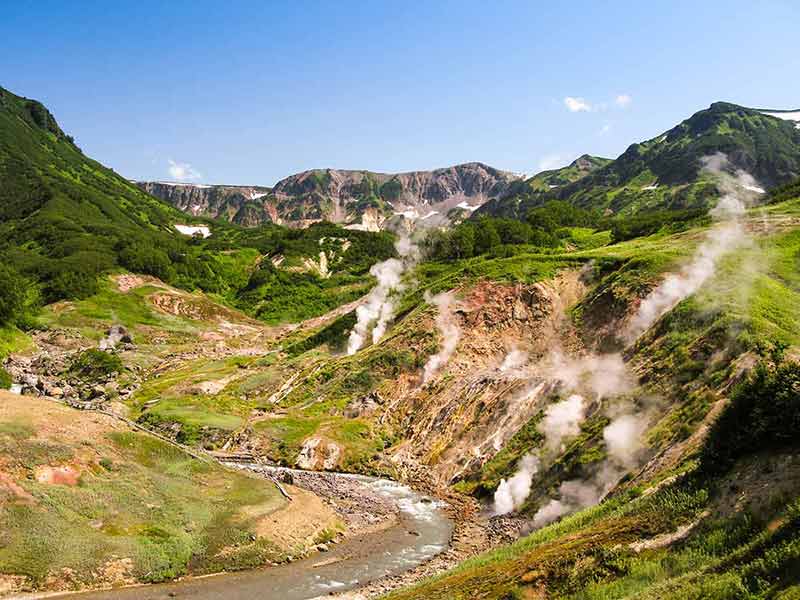
The Valley of Geysers is another natural phenomenon of Russias vast and changing landscape.
The geysers are the only ones of their kind in Eurasia with approximately 200 geysers making up the valley.
Discovered by a local scientist in 1941, the geysers today are a renowned tourist attraction because of the thermal pool, cascading waterfalls and beautiful surroundings.
In 2008 the valley was selected as one of seven wonders of Russia.
The Valley of Geysers is on the Kamchatka Peninsula.
- Things To Do In Moscow
- Russian River Cruises
- Cruising From Moscow To St Petersburg
- 20 Russian Landmarks
- 20 Russian Palaces and Forts
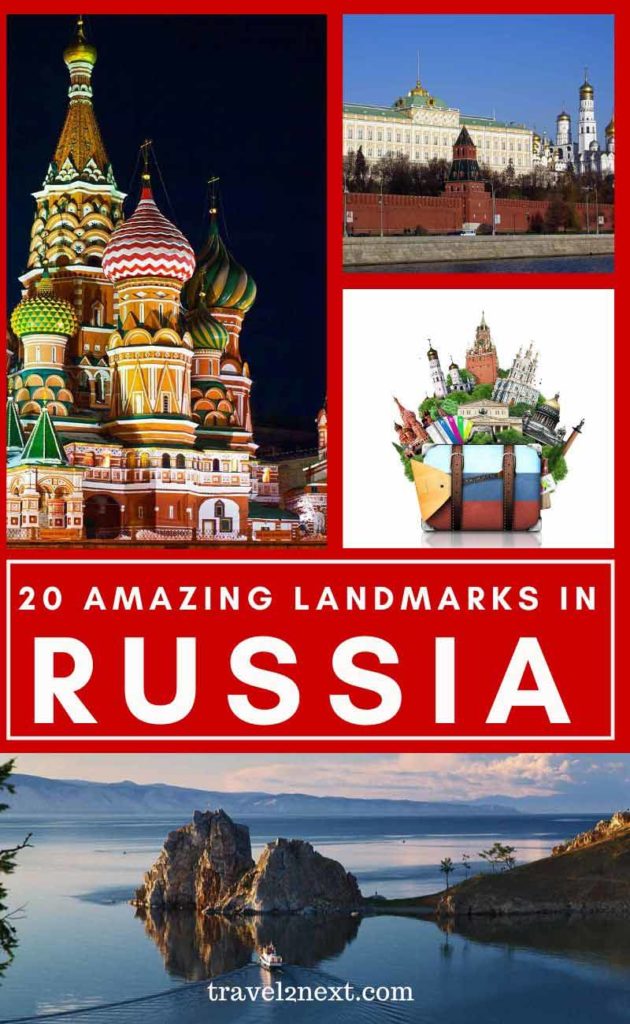
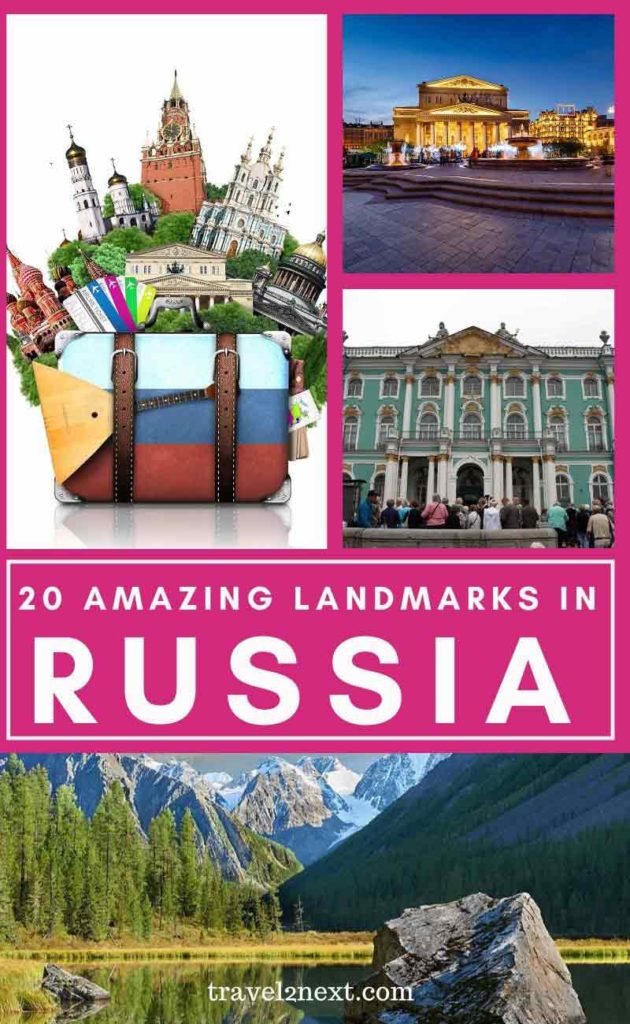
Plan Your Trip

Rent A Car – Find the best car rental rates at Discover Cars. They compare car hire companies to provide you with the best deal right now.

Find A Hotel – If you’re curious about this article and are looking for somewhere to stay, take a look at these amazing hotels.

